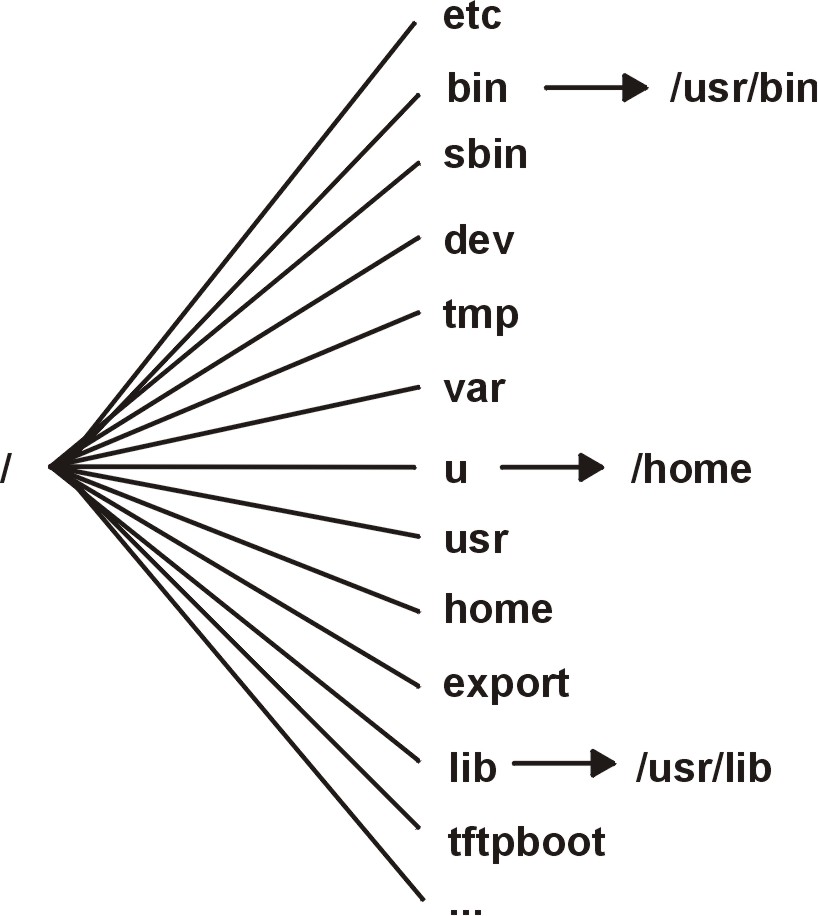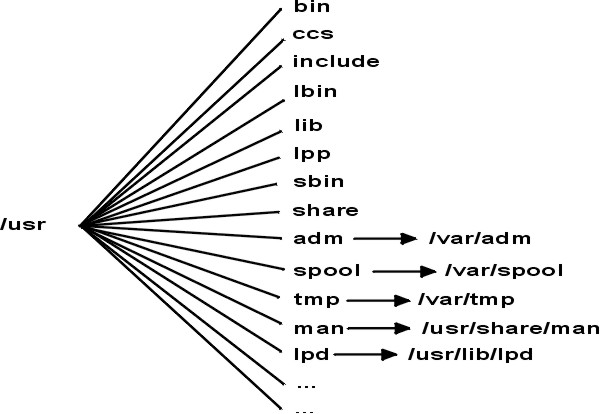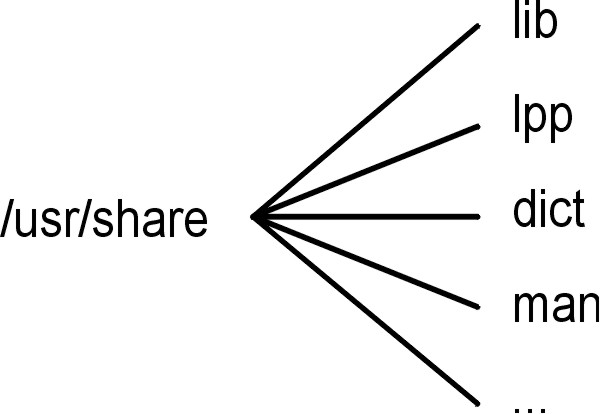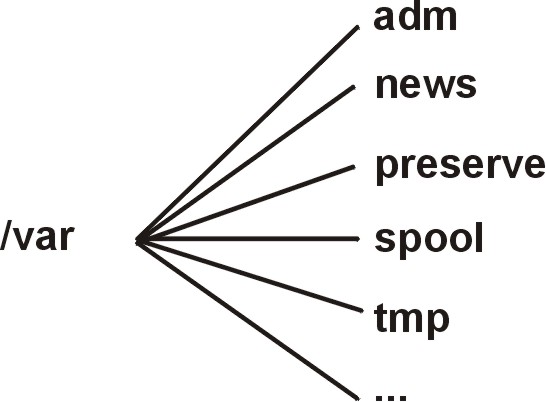
The file tree organizes files into directories containing similar information. This organization facilitates remote mounting of directories and files. System administrators can use these directories as building blocks to construct a unique file tree for each client mounting individual directories from one or more servers. Mounting files and directories remotely, rather than keeping all information local, has the following advantages:
The file tree has the following characteristics:
The root file system is the top of the hierarchical file tree. It contains the files and directories critical for system operation, including the device directory and programs for booting the system. The root file system also contains mount points where file systems can be mounted to connect to the root file system hierarchy.
The following diagram shows many of the subdirectories of the root file system.

The following list provides information about the contents of some of the subdirectories of the / (root) file system.
| /etc | Contains configuration files that vary for each machine. Examples include:
The /etc directory contains the files generally used in system administration. Most of the commands that previously resided in the /etc directory now reside in the /usr/sbin directory. However, for compatibility, the /usr/sbin directory contains symbolic links to the locations of some executable files. Examples include:
|
| /bin | Symbolic link to the /usr/bin directory. In prior UNIX file systems, the /bin directory contained user commands that now reside in the /usr/bin directory. |
| /sbin | Contains files needed to boot the machine and mount the /usr file system. Most of the commands used during booting come from the boot image's RAM disk file system; therefore, very few commands reside in the /sbin directory. |
| /dev | Contains device nodes for special files for local devices. The /dev directory contains special files for tape drives, printers, disk partitions, and terminals. |
| /tmp | Serves as a mount point for a file system that contains system-generated temporary files. The /tmp file system is an empty directory. |
| /var | Serves as a mount point for files that vary on each machine. The /var file system is configured as a file system since the files it contains tend to grow. See Understanding the /var File System for more information. |
| /u | Symbolic link to the /home directory. |
| /usr | Contains files that do not change and can be shared by machines such
as executables and ASCII documentation.
Standalone machines mount the root of a separate local file system over the /usr directory. Diskless machines and machines with limited disk resources mount a directory from a remote server over the /usr file system. See Understanding the /usr File System for more information about the file tree mounted over the /usr directory. |
| /home | Serves as a mount point for a file system containing user home directories.
The /home file system contains per-user files and directories.
In a standalone machine, the /home directory is contained in a separate file system whose root is mounted over the /home directory root file system. In a network, a server might contain user files that are accessible from several machines. In this case, the server copy of the /home directory is remotely mounted onto a local /home file system. |
| /export | Contains the directories and files on a server that are for remote
clients.
See Understanding the /export Directory for more information about the file tree that resides under the /export directory. |
| /lib | Symbolic link to the /usr/lib directory. See Understanding the /usr File System for more information. |
| /tftpboot | Contains boot images and boot information for diskless clients. |
The /usr file system contains executable files that can be shared among machines. The major subdirectories of the /usr directory are shown in the following diagram.

On a standalone machine the /usr file system is a separate file system (in the /dev/hd2 logical volume). On a diskless machine or a machine with limited disk resources, a directory from a remote server is mounted with read-only permissions over the local /usr file system. The /usr file system contains read-only commands, libraries, and data.
Except for the contents of the /usr/share directory, the files and directories in the /usr file system can be shared by all machines of the same hardware architecture.
The /usr file system includes the following directories:
| /usr/bin | Contains ordinary commands and shell scripts. For example, the /usr/bin directory contains the ls, cat, and mkdir commands. |
| /usr/ccs | Contains unbundled development package binaries. |
| /usr/include | Contains include, or header, files. |
| /usr/lbin | Contains executable files that are backends to commands. |
| /usr/lib | Contains architecture-independent libraries with names of the form lib*.a. The /lib directory in / (root) is a symbolic link to the /usr/lib directory, so all files that were once in the /lib directory are now in the /usr/lib directory. This includes a few nonlibrary files for compatibility. |
| /usr/lpp | Contains optionally installed products. |
| /usr/sbin | Contains utilities used in system administration, including System Management Interface Tool (SMIT) commands. Most of the commands that once resided in the /etc directory now reside in the /usr/sbin directory. |
| /usr/share | Contains files that can be shared among machines with different architectures. See Understanding the /usr/share Directory for more information. |
| /usr/adm | Symbolic link to the /var/adm directory |
| /usr/mail | Symbolic link to the /var/spool/mail directory |
| /usr/news | Symbolic link to the /var/news directory |
| /usr/preserve | Symbolic link to the /var/preserve directory |
| /usr/spool | Symbolic link to the /var/spool directory |
| /usr/tmp | Symbolic link to the /var/tmp directory, because the /usr directory is potentially shared by many nodes and is read-only |
| /usr/dict | Symbolic link to the /usr/share/dict directory |
| /usr/man | Symbolic link to the /usr/share/man directory |
| /usr/lpd | Symbolic link to the /usr/lib/lpd directory |
The /usr/share directory contains architecture-independent shareable text files. The contents of this directory can be shared by all machines, regardless of hardware architecture.
In a mixed architecture environment, the typical diskless client mounts one server directory over its own /usr directory and then mounts a different directory over the /usr/share directory. The files below the /usr/share directory are contained in one or more separately installable packages. Thus, a node might have the other parts of the /usr directory it depends on locally installed while using a server to provide the /usr/share directory.
Some of the files in the /usr/share directory include the directories and files shown in the following diagram.

The /usr/share directory includes the following:
| /usr/share/man | Contains the manual pages if they have been loaded |
| /usr/share/dict | Contains the spelling dictionary and its indexes |
| /usr/share/lib | Contains architecture-independent data files, including terminfo, learn, tmac, me, and macros |
| /usr/share/lpp | Contains data and information about optionally installable products on the system |
Specific /var files that warrant periodic monitoring are /var/adm/wtmp and /var/adm/ras/errlog.
Other /var files to monitor are:
| /var/adm/ras/trcfile | If the trace facility is turned on |
| /var/tmp/snmpd.log | If the snmpd command is running on your system |
The /var directory diagram shows some of the directories in the /var file system.

| /var/adm | Contains system logging and accounting files |
| /var/news | Contains system news |
| /var/preserve | Contains preserved data from interrupted edit sessions; similar to the /usr/preserve directory in previous releases |
| /var/spool | Contains files being processed by programs such as electronic mail; similar to the /usr/spool directory in previous releases |
| /var/tmp | Contains temporary files; similar to the /usr/tmp directory in previous releases. The /usr/tmp directory is now a symbolic link to /var/tmp. |
The /export directory contains server files exported to clients, such as diskless, dataless, or disk-poor machines. A server can export several types of disk space, including packages of executable programs, paging space for diskless clients, and root file systems for diskless clients or those with low disk resources. The standard location for such disk space in the file tree is the /export directory. Some of the subdirectories of the /export directory are shown in the following list:
The /export directory is the default location for client resources for the diskless commands. The /export directory is only the location of client resources on the server. Because clients mount these resources onto their own file tree, these resources appear to clients at the normal places in a file tree. The major subdirectories of the /export directory, and their corresponding mount points on a client file tree, include: